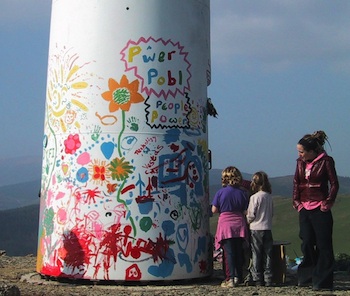Green power and local ownership in action
Situated at the coast of Mid Wales around the estuary of the Afon Dyfi, this biosphere reserve is representative of salt marshes, estuarine systems, farmland, woodland and moorland in the west of the United Kingdom. Biosffer Dyfi Biosphere consists of the catchment of the river Dyfi plus the town of Aberystwyth.
Bro Dyfi Community Renewables Ltd (BDCR) is a community owned renewable energy company. It aims to promote wind and other renewable energy projects that benefit local people and that are subject to a significant degree of local control.
BDCR is an example of communities and environmentally conscious investors coming together to create and deliver local schemes that are a direct response to climate change, boost local regeneration and strengthen self-reliance.
Wind energy for the community
BDCR owns two wind turbines near Machynlleth: a 75kW Vestas and a 500kW Nordtank.
In April 2003 the UK’s first wind turbine owned and developed by the community was switched on in the Dulas valley, a tributary of the Dyfi. Residents of Pantperthog village initially conceived the idea for a community-owned wind turbine in October 1999, which led to the installation of the 75kW second-hand Vestas wind turbine, located on the hill above the Centre for Alternative Technology (CAT).
BDCR’s most recent project was to replace an existing non-operational wind turbine (MS4) on Mynydd Glandulas, above the Centre for Alternative Technology, using finance raised by a further share offer. Using European funding secured through Mid Wales Energy Agency and ecodyfi, and shareholders’ investments, a second hand Nordtank NTK500/37 (500KW) wind turbine was acquired and installed on Mynydd Glandulas in 2008. It became operational in 2010.
The benefits of a project designed and delivered at the local level
The wind turbine project has resulted in a number of direct economic benefits to the local community, many of which would not have occurred if the installation had been by a non-local developer:
- The work undertaken in developing the project was carried out by members of the local community;
- The partnership placed the construction contract with a local company (CAT) and other local suppliers;
- Some of the people involved in the project agreed for some or all of their work on planning and finance to be paid in shares in the project;
- The first project alone brought approximately £55,000 into the local economy (70% of the total project cost);
- The administration and operation and maintenance contracts have been placed locally;
- Local and national shareholders continue to draw share interest payments from the revenue of the electricity generated;
- 58% of the revenue from the project will be retained within the local economy, with nearly all the other shareholders being elsewhere in the UK;
- The wind turbine provides an additional demonstration turbine and educational resource for CAT;
- The project is a community-owned scheme where each shareholder has one voting share irrespective of the amount of investment, と
- 17% of the annual project profit goes into community regeneration and energy efficiency measures, through ecodyfi and a community energy fund, それぞれ.
Lessons learned and replicability
When running a community energy project it is essential that thinking is given to the ongoing running and administration of the organisation once it is up and running. Preferably a proportion of generation income should be channelled towards employing persons locally on a part time basis to run the affairs of the business. Some issues were resolved more slowly by the voluntary Committee members than would have been the case in a commercial organisation.
While many communities have the organisational and financial skills needed to manage such a project, not many have the technical skills needed to develop it, for example choice of turbine technology, civil engineering needs, the planning application and associated reports (predicted noise, landscape, archaeology etc. impacts). These services will usually have to be bought in, while the project is still at risk, so public funding of such feasibility work is desirable.
The project has received significant publicity and helped raise the profile of the community dimension of wind developments as seen, 例えば, in the Technical Advisory Note on renewable energy in Wales. 加えて, 学者や他のコミュニティサイトを訪問したり、独自の研究や計画を通知するための情報を求めているか.

















